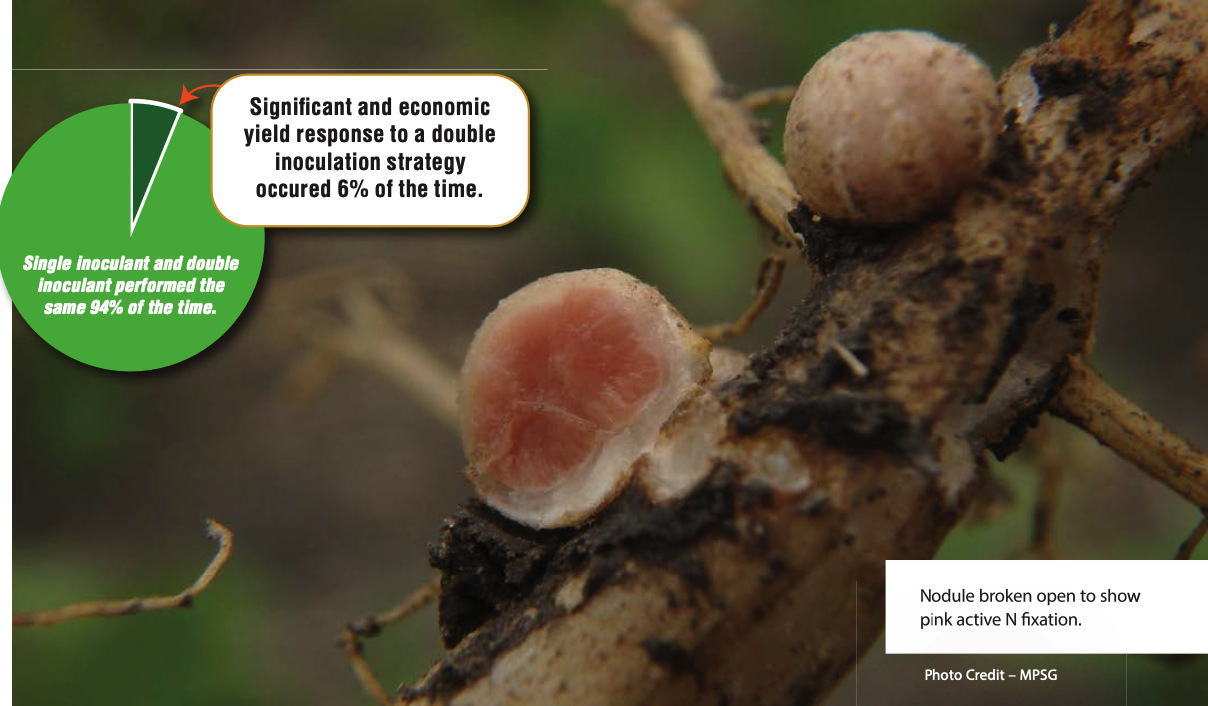Leanne Koroscil, former On-Farm Network Agronomist, MPSG
SPRING THAW IS around the corner, and soon the snow in the fields will be replaced with tractors, seed and various spring inputs. The type, quantity, and timing of inputs will influence the seasonal outcome and remain an important aspect of short- and long- term planning, year after year. One of the key decisions a soybean farmer should make involves inoculation. What form of inoculant (liquid, peat, granular) should be used? Is it economical to reduce a double inoculant application to a single application, given the field history? All critical questions to reflect on as the growing season approaches.
THE INS AND OUTS OF SOYBEAN INOCULATION
Soybeans have an amazing ability to fix nitrogen (N) through a symbiotic relationship with soil bacteria called Bradyrhizobium japonicum. B. japonicum are activated by chemical compounds (otherwise known as root exudates) released from soybean roots, which trigger B. japonicum to release compounds detected by soybeans in turn. For the following two to three weeks, these compounds signal fine root hairs to wrap around the B. japonicum and capture them in what will soon become a nodule.
Nodules can be cut in half and examined for pink or red colouring caused by the oxygen-carrying protein leghemoglobin. Much like hemoglobin in blood, leghemoglobin turns colour when exposed to oxygen. Grey or white nodules indicate that biological N fixation has not begun; pink or red nodules indicate that the nodule is actively fixing N.
Once actively fixating, soybeans fix, on average, 58% of their own N requirement. Crops with the ability to biologically fix N, such as field peas and faba beans, relate to different species of rhizobium. Soybeans specifically have a relationship with the bacteria, B. japonicum, though other strains such as B.elkanii have been noted. However, soybean rhizobia are not native to Manitoban soils and a compatible inoculant should be used in fields with little to no history of soybeans.

A study funded by Manitoba Pulse & Soybean Growers (MPSG) and researched by Patricia Ordonez and Dr. Ivan Oresnik at the University of Manitoba examined the longevity of B. japonicum in Manitoban soils. Predictably, populations of B. japonicum declined in relation to the time since the last inoculated soybean crop (Figure 1). However, cropping history mattered. At sites with soybean history (Carman and St. Adolphe) populations declined much more slowly than at Melita, a site with no soybean history prior to this research.
INOCULATION STRATEGIES
Inoculant is available in a variety of forms including liquid and peat on-seed, and granular in-furrow. Each varies in cost, the proximity to the seed during placement, and the length of time the inoculant product survives in the field when faced with adverse environmental conditions. A double inoculation strategy is typically used for first- or second-time soybean fields. In this scenario, two different inoculants or placements are used, such as liquid on-seed plus granular in-furrow, to ensure proper introduction of rhizobia to the soil.
Once a soybean field has been inoculated for a minimum of two years, a farmer may consider reducing their strategy to a single application for economical reasons. Before reducing inoculation strategies, MPSG strongly encourages using the checklist below since crop nutrition, environment and soil conditions can all influence nodulation (Figure 2). An On-Farm Network (OFN) field-scale inoculant trial can also
offer additional insight using your own equipment, fields and production practices unique to your farm.
ON-FARM NETWORK INOCULANT TRIALS
OFN inoculant trials were initiated to quantify the agronomic and economic impacts of different inoculant strategies in soybeans. There are two types of inoculant trials: 1) double vs. single inoculation, and 2) single versus no inoculation. Double vs. single inoculant trials require a minimum field history of two previous soybean crops to ensure proper B. japonicum populations are established, while single versus no inoculant trials require a minimum field history of three previous soybean crops. For both inoculant trial types, a soybean crop must have been grown on the chosen field sometime within the last four years.
In-season measurements include plant counts to monitor the population in relation to the actual seeding rate, nodulation ratings to evaluate the efficacy of the inoculant, yield collection to determine the effect of inoculant on soybean yield and protein analysis to examine the effects of inoculant on protein levels within the soybean seed.
Over the last 10 years, there have been 49 double vs. single inoculant trials tested on farm through the OFN. At three of these trials, a significant positive yield response was attributed to the double inoculation strategy, meaning a double inoculant strategy paid only 6% of the time on fields with soybean history.
Positive yield responses in agricultural research are eye-catching and can occasionally be misunderstood as a sole defining factor for valid scientific results. On the contrary, a lack of yield response in certain trials can actually be beneficial. For instance, the OFN has conducted 38 single vs. no inoculant trials since 2016 and there has not been a significant yield response to inoculation in those fields with more soybean history.

The lack of yield responses in both inoculant trial types can inform farmers that it is feasible to reduce their inoculation strategies in following years provided the field has enough soybean history.


